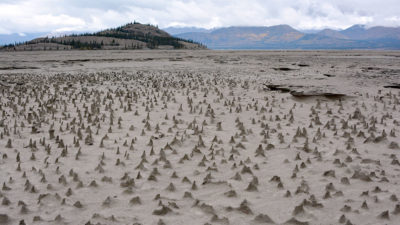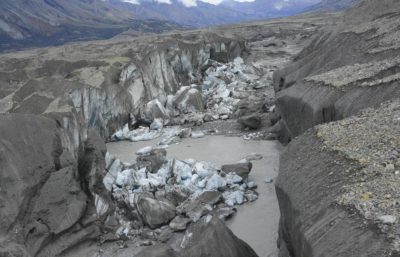Yale Environment 360
Published at the Yale School of Forestry & Environmental Studies
The newly exposed bed of Kluane Lake in the Yukon. The Kaskawulsh Glacier has been retreating so rapidly that its meltwater carved a new path that cut off flow into the river that feeds the lake, causing water levels to drop more than four feet and exposing parts of the lake bottom. JIM BEST/UNIVERSITY OF ILLINOIS
How Warming Is Profoundly Changing a Great Northern Wilderness
The abrupt change in direction of a Yukon river because of a rapidly melting glacier has attracted international attention. But this bizarre development is just one of many climate-driven events that are transforming a vast sub-Arctic area of Canada and Alaska.
Last week, a scientific study from the world’s largest sub-polar ice field, centered in southwestern Yukon, reported a finding so bizarre that it made international news: A massive glacier — three miles wide and covering 10,000 square miles — was retreating so rapidly that its meltwater had carved a new path that cut off the long-term flow into one river and channeled most of the flow into another. Scientists even had a name for this phenomenon — “river piracy” — and linked it to the rapid warming of this sub-Arctic region.
But what was largely overlooked in reports about the re-routing of meltwater from the Kaskawulsh Glacier is that it’s just one of numerous climate-driven, threshold-crashing events that have been throwing the ecosystem in Canada’s Kluane National Park off kilter. Together with Wrangell-St. Elias National Park and Preserve — the largest national park in the United States — Kluane park comprises a vast area of towering mountains, forests, alpine valleys, and glaciers experiencing major climatic, glaciological, and ecological changes as Arctic and sub-Arctic regions swiftly warm. And as the hijacking of a river in Kluane park demonstrates, these changes are sometimes rapid and unpredictable.
Kluane National Park in southwestern Yukon, in the center of a vast, ice-bound area in Canada and Alaska undergoing rapid climate change. PARKS CANADA
Temperatures in the Yukon have increased by more than 2 degrees C — 3.6 F — in the past 50 years, a key factor in the retreat of glaciers such as the Kaskawulsh. In the boreal forest regions of Kluane National Park, the spruce bark beetle — a temperature-sensitive insect that has destroyed tens of millions of acres of evergreen forests in western North America — has infested approximately 900,000 acres of forest. In the Alpine and tundra areas of Kluane, trees and woody shrubs are taking over the lichen, sedge and grasslands of the tundra. Wetlands are drying up, and some invasive plants, such as European dandelion, have shown up on the fringes of the park.
Wildlife populations such as moose, Dall sheep, red squirrels, and snowshoe hare are either declining or shifting or doing things that are making scientists scratch their heads. Caribou and sheep are dispersing, possibly because woody shrubs are overtaking alpine and tundra ecosystems. Mountain lions are now moving into the region, following deer that have shown up from the south because frigid winters are no longer holding them back.
“In many ways, Kluane is a speeded-up version of what is happening throughout the world,” says Garry Clarke, an emeritus professor of glaciology at the University of British Columbia, who first started working in the park in 1962. “It’s a compelling landscape, breathtaking in so many ways, and always changing. But because of climate change, the landscape changes are being pushed forward faster than what you’d normally expect.”
The unraveling of the river piracy mystery began late last summer. Then, University of Washington geomorphologist Dan Shugar and his colleagues travelled north to Kluane Park to see how glacial sediments in the Slims River — fed by the Kaskawulsh Glacier — affected the delta and lake bottom of Kluane Lake. At 158 square miles, Kluane Lake is almost as large as Lake Tahoe, the largest alpine lake in North America.
Two years earlier, local bush pilots had reported that the Slims River wasn’t flowing as robustly as it once had. When Shugar’s team arrived on the scene, however, they were astonished by what they saw. The once-mighty river had been reduced to a trickle, and the enormous lake into which it drained — Kluane— had dropped by more than four feet.
This was the first case of ‘river piracy’ that geologists have seen in modern times, and one that happened swiftly.
Shugar, along with colleagues James Best and John Clague, went to the town of Haines Junction, where they tapped into Wi-Fi and pored over satellite images to try to figure out what had happened. After spotting landscape and hydrological changes, the scientists chartered a helicopter and flew to the toe of the Kaskawulsh Glacier for a closer look. Once there, they observed that the meltwater and outflow from the rapidly retreating river of ice had carved a 100-foot deep canyon that was diverting most of its meltwater into the Kaskawulsh River rather than the Slims. Instead of flowing north into the Bering Sea, via the Slims River, the meltwater was flowing southwest into British Columbia and the Gulf of Alaska.
This was the first case of “river piracy” that geologists have seen in modern times, and one that happened swiftly rather than incrementally, as was usually the case in the distant past. With the Kaskawulsh Glacier steadily retreating, there is little likelihood that the flow of glacial meltwater will be restored to the Slims. Yukon glaciers have lost 22 per cent of their surface area since 1958.
The implications of this river piracy are far-reaching because the Slims is the main source of cold, sediment-rich water flowing into Kluane Lake, which is 50 miles long. Not only does this hijacking of the Slims’ flow have implications for fish such as lake trout and whitefish, but it might also result in Kluane Lake becoming too shallow to drain into the river that bears its name. If that were to happen, as Simon Fraser university scientist John Clague suspects, the lake would become hydrologically isolated and subject to major chemical and biological changes.
Clague, who first visited Kluane in 1980, says that groundwater may keep the Slims River flowing to some degree. He notes that there is an engineering solution to this latest development – diverting the flow of water from the Duke River, which flowed into Kluane Lake in ancient times, back into the lake.
Recently collapsed ice blocks in the ice-walled canyon at the terminus of the Kaskawulsh Glacier. Increasing meltwater from the glacier has carved a new path, with water flow now heading west into the Gulf of Alaska rather than north into the Bering Sea. JIM BEST/UNIVERSITY OF ILLINOIS
“It can be done, and it would be costly,” says Clague. “But when you add it all up, we can’t afford all the engineering solutions that are going to come up across the world as a result of climate change.”
Established in 1972, Kluane National Park attracts hikers, climbers, sports fishermen, and tourists. In 1965, Robert F. Kennedy climbed the 13,944-foot-high mountain that now bears his name. Caravans of tourists regularly pass through the park along the Alaska Highway.
Dramatic landscape changes are a fact of life in this part of the world, as Garry Clarke can attest. Before global warming really kicked in, he was there in the 1960s when the Steele Glacier surged so quickly that glaciologists nicknamed it the Galloping Glacier. And back in the late 17th century, the Slims had once flowed the other way and had drained Kluane rather than filling it up.
But Clarke and Clague, as well as ecologists Ryan Danby of Queen’s University and David Hik of the University of Alberta, see the recent developments in a different and more disturbing light — that of rapid, human-caused climate change.
Danby and Hik have worked in the park for decades, tracking the growth rates and migration of trees and woody shrubs into south-facing alpine slopes and tundra valleys. An increase in shrub growth may not sound that significant when compared to the advance of trees such as spruce, which are moving higher up in the alpine country and closer to the Arctic coast as the climate warms. But shrubs such as alder, willow, and dwarf birch grow a lot faster than trees and shade out sunshine that lichens, mosses, and other alpine/tundra plants need to thrive during a growing season that is often measured in weeks rather than months.
‘For me, this is a metaphor for what is happening in the rest of the world,’ says one researcher.
The changes in vegetation are already driving Dall sheep, caribou, collared pikas, and hoary marmots into increasingly shrinking tundra and alpine ecosystems. Caribou can adapt, but they will have to compete with moose and deer. Pikas and marmots are unlikely to adapt because their fate — and feeding habits — are closely linked to alpine and tundra ecosystems.
The recent advance of the spruce bark beetle is having similar impacts on Kluane’s boreal forest, which is home to wolves, lynx, snowshoe hares, grizzlies, moose, and many nesting birds. Beetle outbreaks have occurred in the past in Kluane. One that occurred in the 1940s was probably linked to wood harvesting that was done to build the Haines Highway. But as big as that outbreak was, the beetles infested only a tenth of the forest area that they have attacked since the 1990s.
Ecologist Stan Boutin of the University of Alberta and population ecologist Charley Krebs, professor emeritus at the University of British Columbia, agree that climate change is dramatically altering the ecosystem in and around Kluane park. They and University of Toronto scientist Rudy Boonstra have spent more than 100 years between them studying many of the region’s animals. The challenge for them is linking the changes in the Kluane area to climatic shifts because climate in the region is so variable. Other factors, such as predation and food availability, also play an important role. Snowshoe hare cycles, for example, are linked to the stress they suffer while being preyed upon by lynx, wolves, owls, and coyotes, whose numbers in the sub-Arctic are rising.
Less input from the Slims River has lowered the water level of Kluane Lake, the largest lake in the Yukon, exposing sediments and creating dust storms. JIM BEST/UNIVERSITY OF ILLINOIS
“If there’s one thing that I’ve learned since I started working in the Kluane region in 1988 is that this is a resilient ecosystem,” says Hik. “Neither the glaciers nor the Slims River are going to come back. But we have seen that some animals such as collared pikas, which I thought at one point were on their way out, are making a comeback. So there is hope, if we can figure out a way of slowing climate change.”
Scientists say that increased research funding from the Canadian government is needed to better understand this rapidly changing region. “If we are not monitoring, we are very likely going to miss events that can fundamentally change an ecosystem, like this case of river piracy is likely to do,” says Hik.
Clague wants to return to Kluane to better understand how breaches in the glacial barrier will impact ecosystems on both sides of the former divide separating the Slims from the Kaskawulsh River. He and other scientists may also collaborate with biologists to determine how the piracy of the Slims River will alter life in one of the largest alpine lakes on the continent.
“It’s rare for a scientist like me to be on the scene of a threshold event such as this,” says Clague. “For me, this is a metaphor for what is happening in the rest of the world. What we need to do is to get society and politicians to pay closer attention.”





